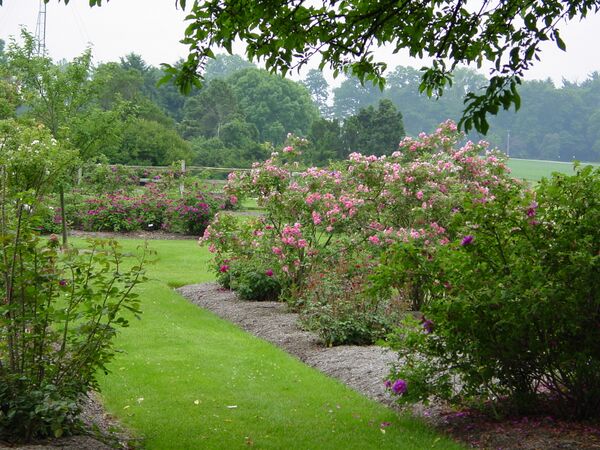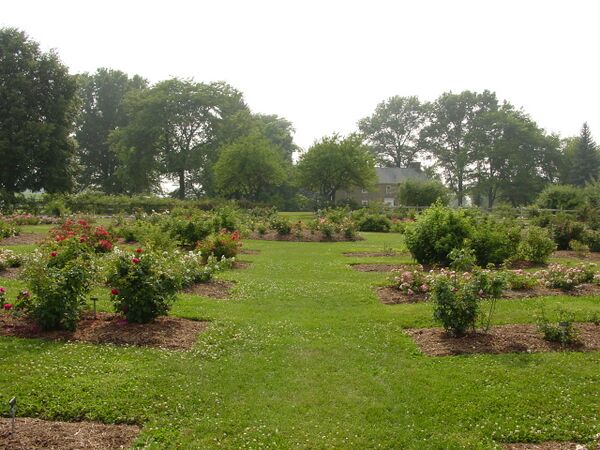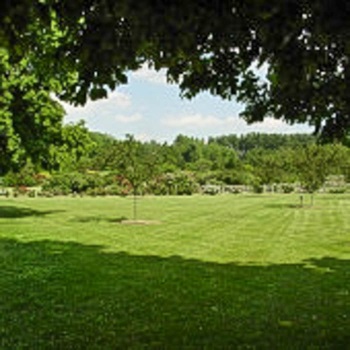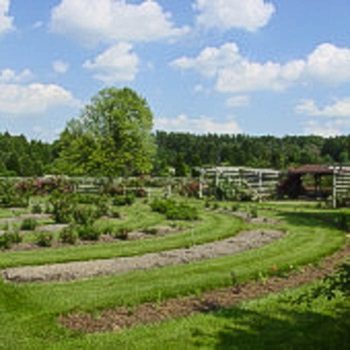Garden of Roses of Legend and Romance
Wooster Garden of Roses of Legend and Romance
- Garden of Roses of Legend and Romance
↑ Nach oben • Top • Vers le haut ↑
Deutsch
Allgemeines
Der Garten wurde 1969 gegründet und enthält immer noch die originalen Rosen, 500 Sorten Historischer Rosen, die vor den modernen Hybriden entstanden. Insgesamt wachsen hier 1.500 Rosen.
Sie bedecken eine Fläche, so groß wie etwa drei Fußballfelder. Die Farben reichen von Rot über Creme, Kupfer, Karmesin, Lachs, Gelb, Burgunderrot und natürlich bis Rosa.
Wenn Sie durch den Rosengarten gehen, werden Sie Rosen sehen, die Sie nicht als solche erkennen würden, hätten sie keine Stacheln. Die Rosen variieren zwischen 50 cm und 7 m, mit allen Zwischengrößen. Sie sind frosthart, duften besonders intensiv und haben den Test der Zeit bestanden.
In den beiden ersten Wochen des Juni erreicht die Blüte ihren Höhepunkt. Viele Historische Rosen blühen nur einmal, d.h man muss den Besuch genau planen, um sie in ihrer vollen Pracht zu sehen und ihren Duft zu genießen.
Lage
Garden of Roses of Legend and Romance
Williams Rd.
Agricultural Research and Development Center
1680 Madison Ave
Wooster, Ohio, USA
- Für Fragen zu Pflanzen oder zum Garten:
Telefon: Kelly King: 330-263-3612 oder eMail: king.1364@osu.edu
- Für Führungen:
Telefon: Jane Houin: 330-202-3507
- Für Hochzeits-Reservierungen:
Telefon: Debbie Shaffer: 330-263-3738
- Parken:
Am Eingang Williams Rd., frei.
Öffnungszeiten
- An allen 7 Tagen der Woche geöffnet, von 1/2 Stunde vor Sonnenaufgang, bis 1/2 Stunde nach Sonnenuntergang.
Eintrittspreise
Freier Eintritt
Gastronomie
Große Auswahl an Restaurants etc. im Zentrum von Wooster.
Geschichte
In den 1960 Jahren wurde The Garden of Roses of Legend and Romance durch den Einsatz und die Großzügigkeit von Spendern initiert, so von Joseph J. Kern, Rosengärtner aus Mentor, Ohio und Frau Samuel J. Forbes, im Gedenken an ihren verstorbenen Vater Michael H. Horvath. Diese perfekte Kombination von Ressourcen führte zur Planung und Umsetzung der Ideen, sodass im Juni 1970 der Rose Garden Dedication Tag, die Eröffnung des Gartens stattfinden konnte.
Joseph J. Kern war ein begeisterter und hingebungsvoller Rosengärtner, der seinen Betrieb "Joseph J. Kern Rose Nursery" über mehr als vier Jahrzehnte führte. Kern lieferte über 1.500 Rosen, das waren fast 500 verschiedene Sorten, für den Garden of Roses of Legend and Romance, und lieferte über viele Jahre Ersatzpflanzen. Seine Sammlungen Historischer Rosen waren die größten in den Vereinigten Staaten, und während der Zeit der Gartenentstehung standen sie auch zum Verkauf für die Allgemeinheit. Sein Betrieb existiert nicht mehr, aber die berühmten Rosen leben weiter.
Michael H. Horvath hatte die Wüchsigkeit, Widerstandsfähigkeit gegrn Krankheiten und Kälte, der in Amerika heimischen Wildrose Rosa setigera Michx., auch bekannt als 'Prairie Rose', erkannt. Diese Art ist in den Feldern, Wiesen und an Straßenrändern im Mittleren Westen reich vertreten, wo ihre attraktiven und zahlreichen Blüten Ende Juni und im Juli das Landschaftsbild beleben. Natürliche Hybridisierung mit anderen Wildarten kommt kaum vor. Zweifellos war Horvaths Vision einer großblumigen, harten Kletterrose eine Herausforderung für ihn. In dem Artikel "Pioneering among the Roses", den er 1939 für das American Rose Annual schrieb, stellte er die Frage: "Was ist Hybridisation?" "Meine eigene Antwort", so sagte er, "es wird eine Kombination von Wissenschaft und Philosophie mit nahezu gleichen Anteilen sein." 'Faszination', 'kritischer Zweifel' und 'gründliches Vorgehen' waren die Zutaten für Horvaths erfolgreiche Rosen-Züchtungen, über die er selbst in genialer Weise verfügte.
Beginnend 1925, führte Horvath mehrere Sorten ein, in denen Rosa setigera nur einen kleineren Anteil hatte. Sie waren hauptsächlich das Ergebnis der Kreuzung eines Rosa setigera x Teerosen-Sämlings mit einer Tee-Hybride. Daraus entstanden die "Treasure Island climbers" (die nach Personen des Romans 'Die Schatzinsel' benannten Kletterrosen), 'Captain Kidd', Jean Lafitte und Long John Silver. Danach beschloss er Rosa setigera Michx. mit Rosa wichurana Crép. zu kreuzen und als weiblichen Elternteil zu verwenden. So entstand die berühmte 'Doubloons', und ebenso 'Mrs. F.F. Prentiss', 'Polaris' und 'President Coolidge'. 'Mrs. F.F. Prentiss' wurde später als Elternsorte für 'Mabelle Stearns', 'Federation' und 'Pink Profusion' verwendet.
Der Garten wurde von Landschaftsarchitekten aus Cleveland, Ohio gestaltet, von William A. Strong und Thomas W. Hill. Ihr Entwurf wurde am 15. April 1969 genehmigt und kurz darauf begannen die Pflanzarbeiten, auf Beeten, die nach den Rosengattungen eingeteilt waren. Die äußere Begrenzung des 2,7 acres (11.000 m²) großen Geländes, ist ein Bretter-Weidezaun (Ranchzaun) mit zahlreichen Ramblern bepflanzt, die sich so frei und üppig ausbreiten können. Das Grundstück des Garden of Roses of Legend and Romance wurde vorher als Viehweide benutzt, sodass umfangreiche Arbeiten zur Umgestaltungs erforderlich waren.
Seit der Eröffnung im Jahre 1969 gab es nur kleinere Umgestaltungen des Gartens. Einige der Rosen gingen ein und wurden nicht ersetzt, andere Sorten kamen später in den Beeten hinzu. Die ursprüngliche Pflanzliste bestand hauptsächlich aus Rosen aus Joseph Kerns Rosengärtnerei, sowie aus Rosen, die er als besonders geeignet für dieses Gebiet auswählte. Kern bestimmte 48 Sorten, die er für ausgezeichnet hielt, einige davon sind: 'Frau Karl Druschki', 'Mrs John Laing', Rosa rugosa Thunb., 'Crested Moss', 'Salet', 'Léda', 'York and Lancaster', Rosa foetida Herrm. var. bicolor (Jacq.) E.Willm., Rosa hugonis Hemsl., 'Rose des Peintres', 'Mme Legras de Saint-Germain', 'Lord Penzance', 'Hermosa', und 'Sombreuil'. Diese Sorten stehen noch im Garten und haben den Test der Zeit bestanden. Die Pflanzen, die nicht gut gediehen und langsam eingingen, wurden ständig ersetzt, soweit sie noch erhältlich sind. Allein dies zeigt, wie wichtig solch ein Garten für den Erhalt und die Zukunft der Rosen ist.
↑ Nach oben • Top • Vers le haut ↑
English
General
Established in 1969, with most of the original plants still thriving, the garden features 500 varieties of old fashioned roses, types that came before modern hybrid roses, with 1,500 specimens in all.
They cover as site that is nearly as big as three footboall fields. Colors included red, cream, copper, crimson, salmon, canary, burngandy, and yes, rose.
Walking through the rose garden you will no doubt see roses that you would not recognixe as roses except for the thorns. The roses vary from 20 inches to 20 feet and everywhere in between. They are hardy, smell especially intense and have survived the test of time.
In June, the first two weeks, is when they hit their peak bloom. Many old roses only flower once, so timing is critical to see and smell them in their glory.
Site
Garden of Roses of Legend and Romance
Williams Rd.
1680 Madison Ave
Wooster, Ohio, USA
- To ask questions about plants or the garden:
Call Kelly King @ 330-263-3612 or email to king.1364@osu.edu
- For Tours:
Call Jane Houin @ 330-202-3507
- For Wedding Reservations:
Call Debbie Shaffer @330-263-3738
- Parking:
At the entrance Williams Rd, free.
Opening hours
- Open seven days a week, from half an hour before dawn to half an hour after dusk.
Admission
Admission is free.
Gastronomy
A wide range of restaurants etc. in the Center of Wooster.
History
In the 1960s, The Garden of Roses of Legend and Romance was inspired by the dedication and generosity of contributors including Joseph J. Kern, Nurseryman of Mentor, Ohio and Mrs. Samuel J. Forbes in memory of her father, the late Michael H. Horvath. This perfect union of resources led to the planning and implementation of those plans that ultimately made the Rose Garden Dedication day of June 1970 possible.
Joseph J. Kern was an enthusiastic and devoted nurseryman that managed his nursery "Joseph J. Kern Rose Nursery" for over four decades. Kern supplied more than 1,500 plants representing nearly 500 varieties to The Garden of Roses of Legend and Romance, and continued with replacements over the years. His collections of antique roses were the largest in the United States, at the time of the donation, available to be bought by the general public. His nursery is not in business anymore but the legendary roses live on.
Michael H. Horvath had observed the vigor, disease resistance and apparent hardiness of the native American rose species, Rosa setigera Michx., also known as the Prairie Rose. This species is most abundant in the fields, pastures, and roadsides of the Midwest where it's attractive and plentiful blooms during the late June and July "enliven the landscape." Natural hybridization of this species with other native species does not readily occur. Undoubtedly, Mr. Horvath's vision of a hardy, large flowered climbing rose appealed to him as a major objective. In an article entitled, "Pioneering among the Roses" written for the 1939 American Rose Annual he raised the question, "What is hybridizing?" "My own answer" he said, "will have to be a combination of science and philosophy in nearly equal parts." 'Fascination,' 'uncertainty,' and 'thoughtful interest' were all part of Horvath's recipe for successful rose breeding, which he himself supplied in such generous quantities.
Beginning in 1925 Mr. Horvath introduced several varieties in which Rosa setigera assumed a minor part. They were largely the result of a Rosa setigera-hybrid Tea Seedling crossed with a Hybrid Tea. As a result he obtained the Treasure Island climbers, 'Captain Kidd', 'Jean Lafitte' and 'Long John Silver'. Naturally, then he decided to cross Rosa setigera Michx. with Rosa wichurana Crép. as the female parent. The result was the famous 'Doubloons', as well as 'Mrs. F.F. Prentiss', 'Polaris' and 'President Coolidge'. 'Mrs. F.F. Prentiss' was later used as a parent in obtaining 'Mabelle Stearns', 'Federation' and 'Pink Profusion'.
The actual garden design came from Landscape Architects in Cleveland, Ohio named William A. Strong and Thomas W. Hill. The formal design of the garden was approved April 15, 1969 and planting began shortly after that with certain assigned beds holding specified varieties of roses. The outer perimeter of the 2.7 acres is a split rail fence where numerous climbers are planted and can extend and grow vigorously. The plot of land that The Garden of Roses of Legend and Romance now is positioned on was previously used for a beef cattle pasture experiment so a lot of work went into the development of the site.
Since the beginning in 1969, there have been some minor transformations in the garden. Some roses that were planted originally have died and were not replaced and some roses that were not in the original plan are now incorporated into the beds. The original planting list was mostly made up of roses that Joseph Kern carried in his nursery, and roses that he chose as exceptional for our area. Kern actually designated 48 varieties as being outstanding with just a few of them being: 'Frau Karl Druschki', 'Mrs John Laing', Rosa rugosa Thunb., 'Crested Moss', 'Salet', 'Léda', 'York and Lancaster', Rose foetida Herrm. var. bicolor (Jacq.) Willm., Rosa hugonis Hemsl., 'Rose des Peintres', 'Mme Legras de Saint-Germain', 'Lord Penzance', 'Hermosa', and 'Sombreuil'. These varieties are still thriving throughout the garden and have stood the test of time. The plants that have not prospered and have gradually disappeared are progressively being replaced if they are still available at all. The Garden of Roses of Legend and Romance is home to rare and unusual plants. That fact alone is exemplary of why a garden of this nature is so imperative to the future of roses.
↑ Nach oben • Top • Vers le haut ↑
Français
Préliminaire
Le parc fut fondé en 1969 et recèle, aujourd'hui encore, les rosiers d'origine, c.-à-d. 500 variétés de rosiers anciens créés avant les hybrides modernes. Au total, ce sont 1.500 rosiers qui sont plantés ici.
Ils couvrent une superficie auusi grande qu'environ trois terrains de football. Les coloris vont du rouge au rose en passant par le crème, le cuivre, le carmin, le saumon, le jaune et le bordeaux.
En vous promenant dans le parc, vous verrez des rosiers que vous n'auriez pu identifier comme tels, s'ils n'avaient pas eu d'épines. La taille des rosiers va de 50 cm à 7 m en passant par toutes les tailles intermédiaires. Ils dégagent un parfum intense, sont résistants au gel et ont résisté au temps.
Leur floraison atteint son summum pendant les deux premières semaines de juin. Bon nombre de rosiers anciens ne fleurissant qu'une seule fois par an, cela implique qu'il faut programmer sa visite pour pouvoir les voir dans toute leur splendeur et repirer leur parfum.
Adresse
Garden of Roses of Legend and Romance
Williams Rd.
1680 Madison Ave
Wooster, Ohio, USA
- Pour toutes les questions relatives aux plantes et au parc:
Téléphone: Kelly King 330-263-3612
E-mail: king.1364@osu.edu - Pour les visites guidées
Téléphone: Jane Houin: 330-202-3507 - Pour les réservations de mariages.
Téléphone: Debbie Shaffer: 330-263-3738
- Stationnement
A l'entrée de la Williams Rd., gratuit.
Heures et jours d'ouverture
- Ouvert 7 jours sur 7, de 1/2 h avant le lever du soleil jusqu'à 1/2 h après le coucher du soleil.
Tarifs
Entrée libre
Restauration
Grand choix de restautants au centre-ville de Wooster
Histoire
La création du parc The Garden of Roses of Legend and Romance fur rendu possible par l'engagement et la générosité de donateurs, dont Joseph J. Kern, pépiniériste de Mentor, Ohio et Frau Samuel J. Forbes, en souvenir de son père Michael H. Horvath. La parfaite combinaison des ressources permit la conception et la réalisation du projet et c'est ainsi que le parc fut inauguré en juin 1970.
Joseph J. Kern était un pépiniériste passionné qui dirigea son entreprise "Joseph J. Kern Rose Nursery" pendant plus de quatre décennies. Kern livra plus de 1.500 rosiers en 500 sortes au Garden of Roses of Legend and Romance. Ses collections de rosiers anciens étaient les plus importantes de tous les Etats-Unis, et durant la création du parc, ils étaient également en vente pour le grand public. Son entreprise n'existe plus, mais ses rosiers vivent encore.
Michael H. Horvath avait décelé la vigueur, la résistance aux maladies et au froid d'un rosier botanique originaire d'Amérique, le Rosa setigera Michx., connu également sous l'appellation de 'Prairie Rose'. Cette espèce se rencontre fréquemment dans les champs et prairies et au bord des chemins du Midwest où ses jolies et nombreuses fleurs égaient le paysage aux mois de juin et juillet. L'hybridisation naturelle avec d'autres variétés sauvages a rarement lieu. Sans aucun doute, l'idée d'un grimpant à grosses fleurs et résistant était un défi pour Horvath. Dans l'article "Pioneering among the Roses", qu'il écrivit en 1939 pour l'American Rose Annual, il se demande: "Qu'est-ce que l'hybridisation?", question à laquelle il répond lui-même: "C'est un mélange de science et de philosophie à parts presqu'égales." La 'fascination', l' 'esprit critique' et une manière de procéder rigoureuse étaient des qualités qu'Horvath possédait dans une mesure extraordinaire et qui lui permirent ses célèbres créations.
Horvath commença son travail en 1925 en introduisant plusieurs variétés pour lesquelles Rosa setigera ne jouait qu'un rôle mineur. Elles étaient le résultat du croisement d'un Rosa setigera x semis de rose Thé avec un hybride de Thé. C'est ainsi que fut créé le groupe des "Treasure Island climbers", des grimpants baptisés d'après les personnages du roman L'Île au Trésor: 'Captain Kidd', Jean Lafitte et Long John Silver. Par la suite, il décida de croiser Rosa setigera Michx. avec Rosa wichurana Crép. et d'en utiliser le résultat comme parent femelle. Furent ainsi créés le célèbre 'Doubloons' ainsi que 'Mrs. F.F. Prentiss', 'Polaris' et 'President Coolidge'. 'Mrs. F.F. Prentiss' fut elle-même utilisée plus tard comme parent pour 'Mabelle Stearns', 'Federation' et'Pink Profusion'.
Le parc fut dessiné par William A. Strong und Thomas W. Hill, des paysagistes venus de Cleveland, dans l'Ohio. Le 15 avril 1969, leur projet fut accepté et peu après, les travaux de plantation commencèrent, dans des plates-bandes assignées aux différentes catégorie. Le pourtour du terrain de 11.000 m² est délimité par une clôture le long de laquelle poussent de nombreux rosiers-lianes pouvant se déployer à leur aise. Ce terrain ayant été, auparavant, utilisé comme pâturages, d'importants travaux de restructuration s'imposaient.
Depuis l'inauguration du parc en 1969, il n'y a eu que de petites modifications. Quelques rosiers périrent et ne furent pas remplacés. Plus tard, d'autres variétés vinrent compléter les plates-bandes. Les rosiers d'origine provenaient principalement des pépinières de Joseph Kern ou avaient été choisis par celui-ci. Kern choisit 48 variétés qu'il considérait comme exceptionnelles et appropriées pour cet environnement, entre autres: 'Frau Karl Druschki', 'Mrs John Laing', Rosa rugosa Thunb., 'Crested Moss', 'Salet', 'Léda', 'York and Lancaster', Rose foetida Herrm. var. bicolor (Jacq.) Willm., Rosa hugonis Hemsl., 'Rose des Peintres', 'Mme Legras de Saint-Germain', 'Lord Penzance', 'Hermosa' et 'Sombreuil'. Ces variétés se trouvent encore dans le parc et ont bravé le temps. Les plantes qui ne prospéraient pas ou périrent furent continuellement remplacées autant qu'il était possible de se les procurer. Rien que cela démontre combien de tels parcs sont importants pour la sauvegarde et l'avenir des rosiers.
↑ Nach oben • Top • Vers le haut ↑




